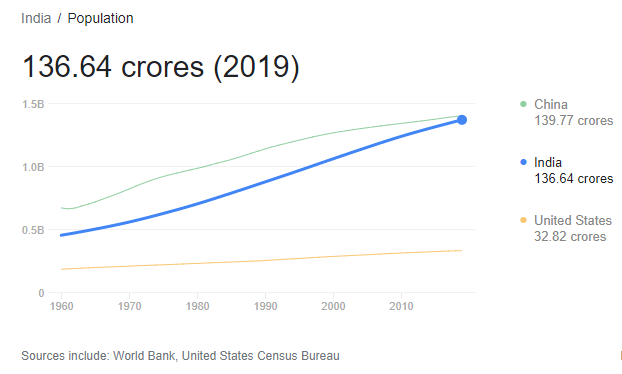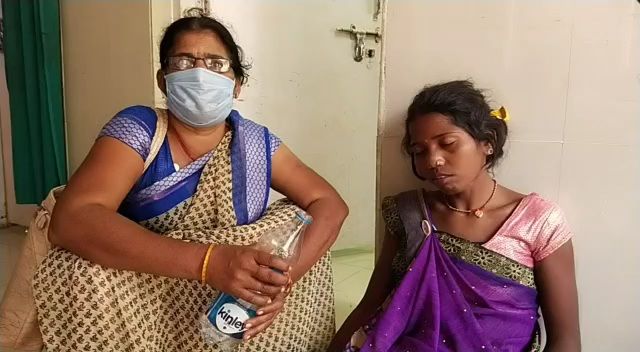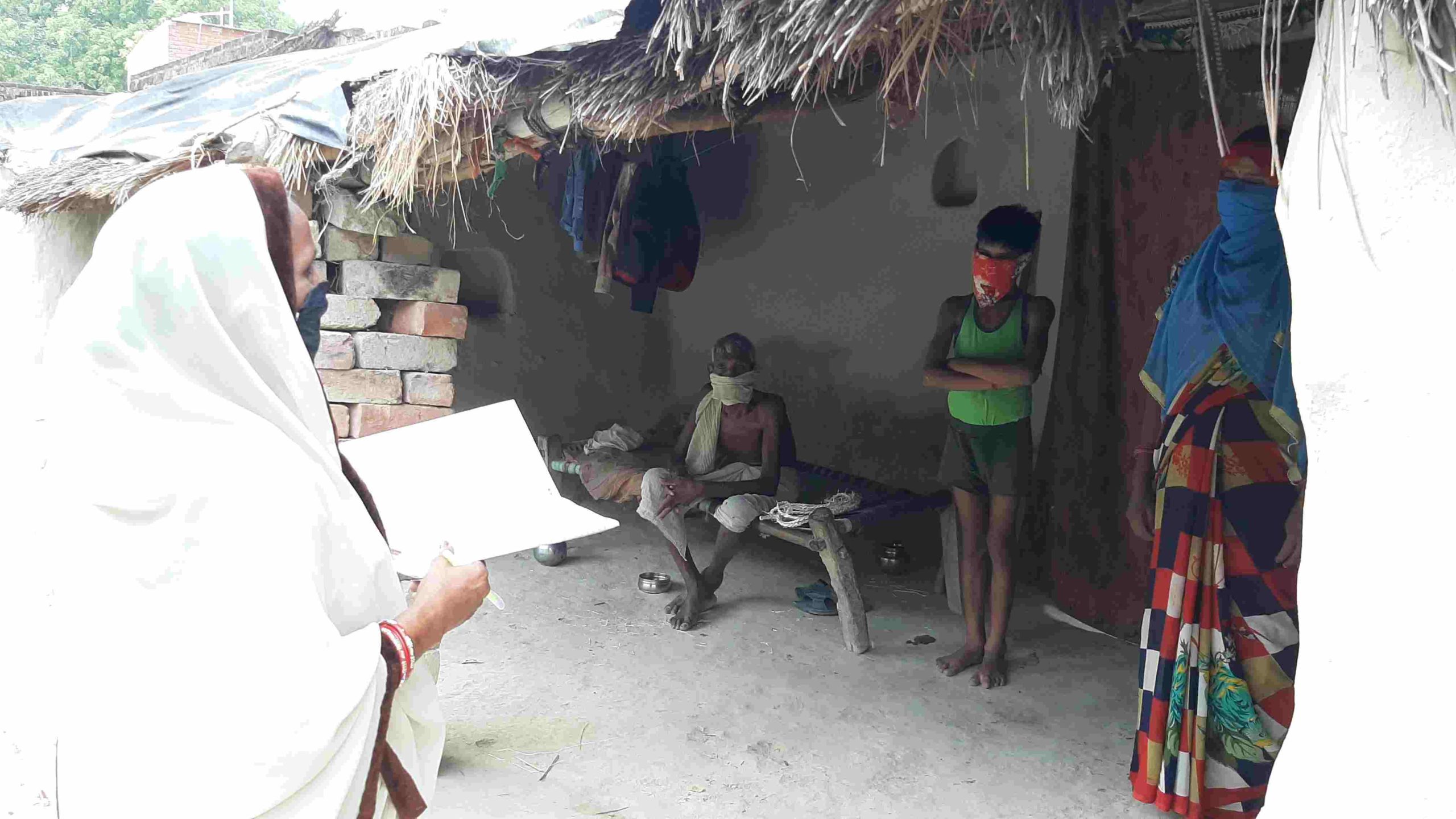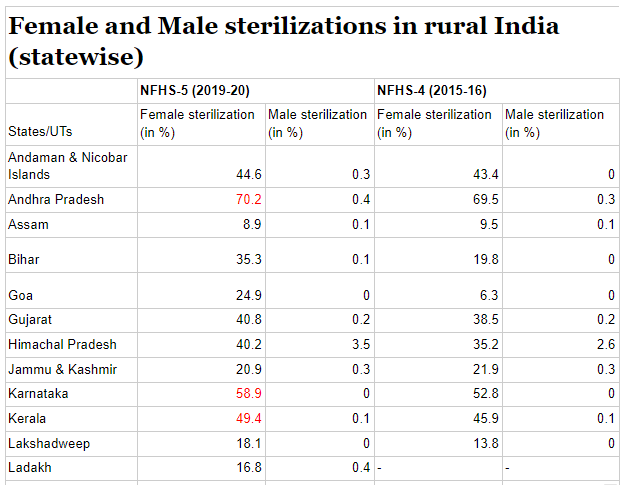NFHS-5: Female sterilisation rises in rural India. Goes up four times in Goa; is highest in Andhra Pradesh at 70%
The National Family Health Survey-5 data shows that 14 of the 20 states and union territories surveyed have recorded a rise in female sterilisation in the hinterland. Why do only women bear the burden of family planning?


A sterilisation camp in Madhya Pradesh where women suffered negligence and indignity. Photo: Gaon Connection
The phase-1 data of the National Family Health Survey-5, shows that 14 of the 20 states and Union Territories surveyed report increasing female sterilisations. The highest number of female sterilisations is in rural Andhra Pradesh — it has marginally increased from 69.5 per cent in 2015-2016 to 70.2 per cent in 2019-2020. This means seven out of 10 married women between the ages of 15 and 49 in rural Andhra Pradesh have been sterilised. But, male sterilisation remains abysmally low in the state — it increased from 0.3 per cent to 0.4 per cent.
The situation is similar across the country. State-wise data shows the southern states of Andhra Pradesh (70 per cent), Telangana (62.2 per cent), Karnataka (59.9 per cent) and Kerala (49.4 per cent) showed high rural women sterilisations in 2019-20.
In fact, female sterilisations in rural Goa increased by four times between 2015-2016 and 2019-2020 — from 6.3 per cent in NFHS4 to 24.9 per cent now.
In the north east, the numbers were lower during 2019-20 — Nagaland (14 per cent), Mizoram (12 per cent), Tripura (nine per cent), Assam (nine per cent), Meghalaya (five per cent) and Manipur (three per cent).

Still, male sterilisations in rural areas of the north east were abysmal — zero per cent for Nagaland, Mizoram, Tripura, and Meghalaya; and 0.1 per cent for Assam and Manipur.
“The type of contraceptives used, especially in rural communities, depends on the central or state governments, and their policies,” Shaibya Saldanha, consultant gynaecologist based in Bengaluru, Karnataka, told Gaon Connection. “The northeastern states may not have the medical facilities to undertake large-scale sterilisations, whereas states such as Uttar Pradesh, Madhya Pradesh and those in the south seem to push for female sterilisation,” she added.

With 1.36 billion people, India is the world’s second-most populated country. It is predicted that the country will overtake China by 2030 in terms of population. India was the first country to introduce a nation-wide family planning programme in 1952, but it still struggles to create an impact. Effective family planning services play a vital role in controlling population growth and enhancing reproductive health care.
Methods of contraception include oral contraceptive pills, implants, injectables, intrauterine devices, condoms and male and female sterilisation. “A lot of states try to undertake postpartum sterilisation because the woman has anyway come to the hospital. Some areas may have poor access to intrauterine devices or oral contraceptive pills. What a government agency distributes is what people use,” said Saldanha.
Also, the government gives incentives to health workers for every sterilisation. “Hence, government hospitals, both rural and urban, suggest this,” she added. According to the 2013 report of the Central Family Planning Division a person who motivates a man to get a vasectomy and a woman to get a tubectomy done receives Rs 200 and Rs 150, respectively, in a government health facility.
The NFHS-5 data shows that while usage of contraceptives has increased, the slant is towards terminal methods, especially female sterilisation, where using mini laparotomy or laparoscopy, the fallopian tubes are either removed or tied.

Burden of family planning on rural women
In a largely patriarchal society where male sterilisation is not accepted, with many saying it impacts virility, India’s family planning programme has traditionally focussed on women. “There’s this deep-rooted mindset that since women give birth, they should also bear the reproductive burden, including contraception. And so, the country’s family planning programmes were driven by population control rather than reproductive health,” Chhaya Pachauli, member, Jan Swasthya Abhiyan, Rajasthan, told Gaon Connection.
“The misconception that vasectomy would lead to lower sex drive and hamper erection has prevailed among men. They are afraid this will result in them losing their mardanagi (manliness),” she added.

The role of millions of Accredited Social Health Activists or ASHA bahu in villages is vital as they provide counselling to women on the importance of safe delivery, breastfeeding, and contraception and child care. Most of them see female volunteers for sterilisation, not men. “Sometimes, men are not ready for sterilisations, but many a time, families or parents do not allow it. They ask us to take their daughter-in-law instead,” Parveen Bano, an ASHA worker from Phanda block, Bhopal district, Madhya Pradesh, told Gaon Connection.
“We try to convince men. They initially agree, but usually back out,” she added.


The story is no different in Bihar, where over 35 per cent of rural women are sterilised, as compared to 0.1 per cent of men, according to the NFHS-5 data. “Men in villages do not want to get sterilised. And patriarchy is to blame for this. Most of the work in villages involves physical labour, and men feel they will lose their strength after sterilisation,” Shashi Yadav, president of ASHA Karyakarta Sangh, Bihar, told Gaon Connection.
Are more male healthcare workers needed?
Most healthcare workers, such as ASHAs, in villages are women. And, many are not very comfortable explaining family planning to men.
The 2016 report of WHO titled ‘Health workforce in India’ shows there are more female (83.4 per cent) than male nurses in India.
Health care experts suggest reproductive health care would improve for both men and women if more male workers were employed in community health care. “Most ASHAs and ANMs [Auxiliary Nurse Midwife] are women, and they are often reluctant to explain and counsel men to opt for contraception. For appropriate counselling of men, we need more male health workers,” said Pachauli.
After the Emergency in 1976, when a forced sterilisation campaign was launched in the country, the gender focus shifted from men to women. “Men could go and talk to men, and that could really make a difference. After the unfortunate misadventure of forced male sterilisation during the emergency years, everybody backed off,” rued Saldanha.

Higher compensation, yet fewer male sterilisations
In order to encourage permanent methods of family planning, the Family Planning Division, Ministry of Health and Family Welfare, provides Rs 1,100 to those undergoing a vasectomy and Rs 600 for women undergoing a tubectomy in a public health facility. Despite the increased compensation for men, female sterilisations are still high. “Increasing incentives is not going to change mindsets. Misconceptions are deep-rooted. There must be more effort to alter men’s perception about their role in reproductive health,” said Pachauli.
Meanwhile, the technical and managerial guidelines for vasectomy services, World Health Organization, has noted that vasectomy is less complex and inexpensive than female sterilisation, and is less demanding of the health system. It is highly effective, does not affect sexual performance, and does not have any known associated health risks. Also, as per the American College of Obstetricians and Gynaecologists, the effectiveness of vasectomy in preventing pregnancy after one year is slightly higher than in female sterilisation.
“The government is also promoting NSV [Non-scalpel Vasectomy]. But it has not really caught on,” said Saldanha, adding: “Sometimes, women say that as husbands are breadwinners of the family, they cannot get operated. Men have to be ‘preserved’ in all circumstances. This mindset needs to be changed.”

